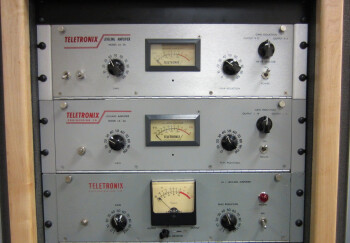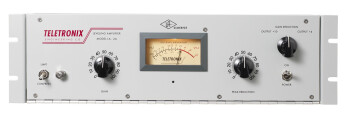A number of outboard compressors from the analog era are considered legends in the audio world, among them the Fairchild 670, UREI 1176, and the subject of this article, the Teletronix LA-2A. The LA-2A offers program-dependent compression based on optical circuitry, and has been ubiquitous in studio processing chains over the years, especially for vocals.
On the level
The LA-2A was the brainchild of an electrical engineer in California named Jim Lawrence, using knowledge of optical sensors he gained while working on the Titan Missile program for the Jet Propulsion Laboratory at Cal Tech in the early ’50’s. It’s fair to say that the optical compressor was one of the positive side benefits of the Cold War. Fortunately, it wasn’t designed to level cities like the Titan, just vocals and other audio signals.
While working at KMGM radio in Los Angeles, Lawrence realized that it would be a lot easier to control signal levels if it could be done automatically, rather than riding a fader or knob. It occurred to him that optical sensing circuitry could be used in the design of such a device, and the the idea for an optical compressor was born.
He developed his novel concept into the T4 optical attenuator, a component that featured an electroluminescent panel inside it that glowed more brightly as the input gain increased. Photo resistors sensed the brightness and lowered the output gain proportionally.
Lawrence launched his own company, Teletronix, to implement his design. Its first product was the LA-1 (LA, of course, stands for “Leveling Amplifier”), of which only about 100 were made. However, one of them found its way to Gene Autry, the famous singing cowboy and movie actor, who used it for recording sessions and radio broadcasts, and spread the word to industry colleagues about the product.
Lawrence continued to refine his design, subsequently releasing the LA-2, a unit that got picked up by large broadcast and recording companies like CBS and RCA. Then in 1962, the even-more-refined LA-2A was introduced, featuring a new wiring scheme and quieter operation. The LA-2A offered program- and frequency- dependent gain reduction (the latter through an adjustable sidechain), with a unique smooth and natural sound, and continued to gain popularity in the pro audio world.
In 1965, a company called Babcock Electronics bought Teletronix from Lawrence. Two years later, Studio Electronics, the company owned by Bill Putnum (and soon to be renamed UREI) bought out Babcock. UREI continued making the tube-based LA-2A until 1969, but in the interim released several other versions LA-3A, LA-4 and LA-5. These units replaced the tube circuitry with solid-state components, and though they still featured an optical compression circuit, the electroluminescent panel from the T4 was swapped out for an LED.
Although it was no-longer in production, the LA-2A became a go-to processor in the recording world, and was used by top engineers on thousands of albums.
When Bill Putnam Jr. revived Universal Audio in 1999, the company began making LA-2As again, painstakingly recreating the the original design. Later, UA modeled the LA-2A as part of its UAD powered plug-in line.
Why it stands apart
So what is it about the LA-2A that makes it so special? It doesn’t have a fancy control set — it’s UI is actually very simple. The Peak Reduction knob, which feeds signal into the side chain circuit, controls the amount of compression (there’s no separate threshold control). The Gain knob governs makeup gain, and is meant to be adjusted after you’ve dialed in your other settings.
Attack time is listed as 10 ms, but is program dependent. Release time starts out at 0.06 seconds during the first 50% of the release period, and then is variable between 0.5 and 5 seconds, depending on the incoming signal. The Limit/Compress switch lets you toggle between infinity for the former and 4:1 for the latter, but that also changes based on the incoming audio.
It’s the LA-2A’s ability to respond to music fed into — especially in terms of its release time — and it’s smooth sounding gain reduction, that give it its special character. Will Shanks, on the UA blog, described the release behavior as follows: “When compression is heavy and/or the signal has been above threshold for a long time, the LA-2A’s release will be slower. This allows you to really hit the LA-2A hard with little or no audible amplitude modulation artifacts.”
(Photographs courtesy of Universal Audio.)


